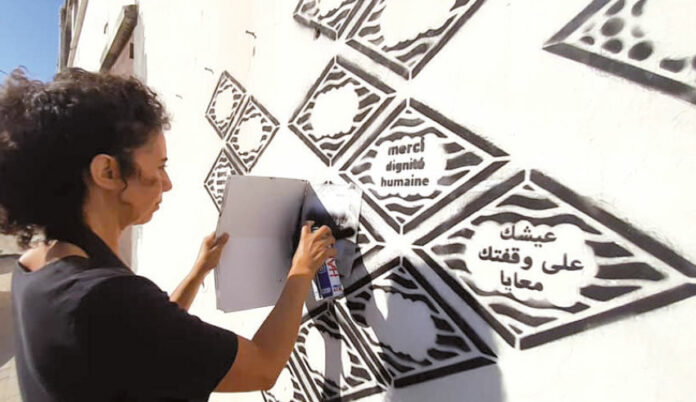“The spatio-temporal framework in which this fourth edition of Visual Utopias evolves aims to create a temporary artistic and intellectual research micro-laboratory. An invitation for a new visual and plastic writing honoring the living in its environment”.
Launched on June 21 and interrupted due to covid, the 4th edition of Utopies Visuelles, organized in Sousse, resumed its artistic wanderings on September 4 to continue until October 3, 2021 at Elbirou Art Gallery.
The founder and master of the place, Karim Sghaier, invites us, throughout the event, to exhibitions, performances and other installations scattered throughout the city of Sousse. The artists show their projects and visions thus creating a free and liberated artistic nebula. “The spatio-temporal framework in which this fourth edition of The Visual Utopias evolves aims to create a temporary micro laboratory for artistic and intellectual research.
An invitation for a new visual and plastic writing honoring the living in its environment, “notes the artistic director of the event, Amira Zili. He added: “The current context, whether social, political, ecological, economic or psychological, can be a driving force to revisit the being in its environment with a new critical and creative perception.”
The Elbirou Gallery will be a starting point for an artistic journey through the medina and the city center of Sousse. Visitors will be able to discover the works of a selection of renowned artists as well as young talents who intend to invest the city and leave their footprints.
On the program: a large collective exhibition entitled “Fragile State”, hosted by the gallery, and which offers works in interaction with the environment: “Currently, in the face of growing environmental questions and the challenges they entail, we see that the links between them and artists seem to be increasingly felt, and vice versa. We can thus read that the planet—its ecosystem—could well become the new great subject of art. Material for narrative, political and media concern, it becomes an omnipresent aesthetic and reflexive support, “writes the curator of the exhibition, Rim Ben Boubaker, specifying that the objective is to confront two currents from the new ecological paradigm that are the sciences of conservation and the ecological art movement. The works, by Alia Derouiche Cherif, Amel Bouslama, Anis Ben Jemâa, Becem Ben Othman, Chahrazed Fekïh, Gneoui Sbaï, Lilia El Golli, Mohamed Ben Soltane, Mohamed Koomanji, Mouna Jemal Siela, Najet Edhahbi, Omar Bey, Safa Attyaoui and Sawsen Laouiti, will try to shed light on the issues of the transmission of our environment.
To discover, also, “Souf-Rologie”, another collective exhibition mounted by Jihene Farhani and Shayma Khili, and which presents wool installations, photography, tapestry paintings at el-1 of Elbirou Art Gallery which, recalls the organizer, was an old wool depot (dating from the 1960s).
A tribute to all those women who, “at a certain time not very long ago, were persecuted and imprisoned because they dared to defend their values. The work of wool was imposed on them as punishment in places like Dar Jouad, including the practice of sewing, embroidery, or tapestry …”, reads the presentation text of the event. The exhibition by changing the context of doing with artistic practice, in this case, that of Younes Ben Hajria, Marïem Marzouki, Nadra Hassen, Ribh Shili, Ameni Ben Salem, Ahlem Hadded, Afrah Ismahene Boubaker, Dali EL Ouni, “makes wool a tool for personal development and a vector of relief and strengthening: wool becomes a sophrology!”, we read again. The same cimaises house the personal exhibition “Lost in Sousse” by Mourad Ben Cheïkh Ahmed. Also to be seen are the urban interventions of Adel Hidar (Message in a bottle at Hadhramout Beach) and Soufïa Bensaïd on the CNP wall (Hadrumète beach).
This Sunday, from 10:00 to 13:00, the artist Mohamed Ben Soltane, in a talk entitled “Portfolio Sesion”, will present his artistic journey in images and analyze the different issues he has addressed since his first solo exhibition in 2007. An opportunity to get an idea of the diversity of his creation in terms of the mediums used and the questions asked.
Rifi-JDD








